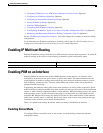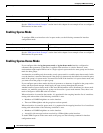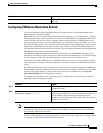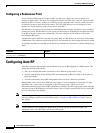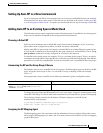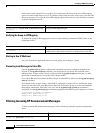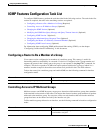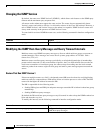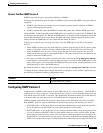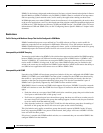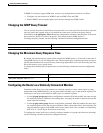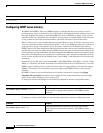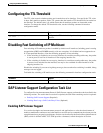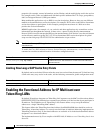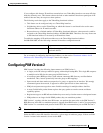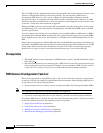
Configuring IP Multicast Routing
IGMP Features Configuration Task List
IPC-411
Cisco IOS IP Configuration Guide
Routers That Run IGMP Version 2
IGMPv2 improved the query messaging capabilities of IGMPv1.
The query and membership report messages in IGMPv2 are identical to the IGMPv1 messages with two
exceptions.
1. IGMPv2 query messages are broken into two categories: general queries (identical to IGMPv1
queries) and group-specific queries.
2. IGMPv1 membership reports and IGMPv2 membership reports have different IGMP type codes.
Unlike IGMPv1, in which the DR and the IGMP querier are typically the same router; in IGMPv2, the
two functions are decoupled. The DR and the IGMP querier are selected based on different criteria and
may be different routers on the same subnet. The DR is the router with the highest IP address on the
subnet, whereas the IGMP querier is the router with the lowest IP address.
IP addresses in general query messages are used to elect the IGMP querier and this is the election
process:
• When IGMPv2 routers start, they each multicast a general query message to the all-systems group
address of 224.0.0.1 with their interface address in the source IP address field of the message.
• When an IGMPv2 router receives a general query message, the router compares the source IP
address in the message with its own interface address. The router with the lowest IP address on the
subnet is elected the IGMP querier.
• All routers (excluding the querier) start the query timer controlled by the ip igmp query timeout
command that is reset whenever a general query message is received from the IGMP querier. If the
query timer expires, it is assumed that the IGMP querier has gone down, and the election process is
performed again to elect a new IGMP querier.
By default, the timer is 2 times the query interval controlled by the ip igmp query-interval command.
To change the query timeout and to specify the period of time before a new election is performed, use
the following command in interface configuration mode:
Configuring IGMP Version 3
IGMP Version 3 (IGMPv3) adds support in Cisco IOS software for “source filtering,” which enables a
multicast receiver host to signal to a router which groups it wants to receive multicast traffic from, and
from which sources this traffic is expected. This membership information enables Cisco IOS software
to forward traffic only from those sources from which receivers requested the traffic.
IGMPv3 supports applications that explicitly signal sources from which they want to receive traffic.
With IGMPv3, receivers signal membership to a multicast host group in the following two modes:
• INCLUDE mode—In this mode, the receiver announces membership to a host group and provides a
list of IP addresses (the INCLUDE list) from which it wants to receive traffic.
• EXCLUDE mode—In this mode, the receiver announces membership to a host group and provides
a list of IP addresses (the EXCLUDE list) from which it does not want to receive traffic. In other
words, the host wants to receive traffic only from sources whose IP addresses are not listed in the
EXCLUDE list. To receive traffic from all sources, like in the case of the Internet Standard Multicast
(ISM) service model, a host expresses EXCLUDE mode membership with an empty EXCLUDE list.
Command Purpose
Router(config-if)# ip igmp query-timeout seconds
Sets the IGMP query timeout.



